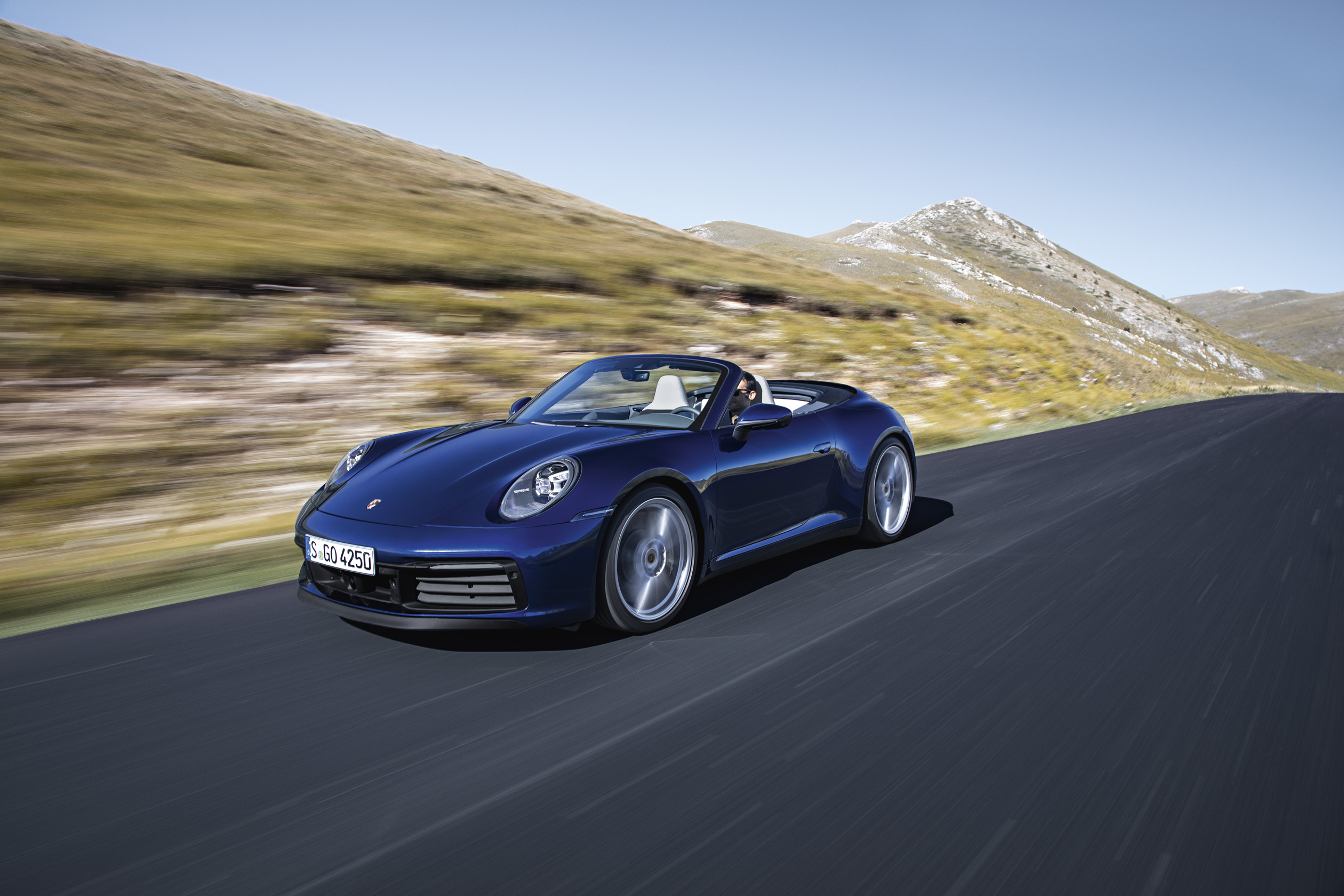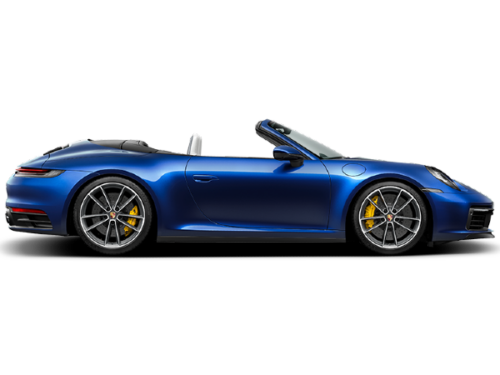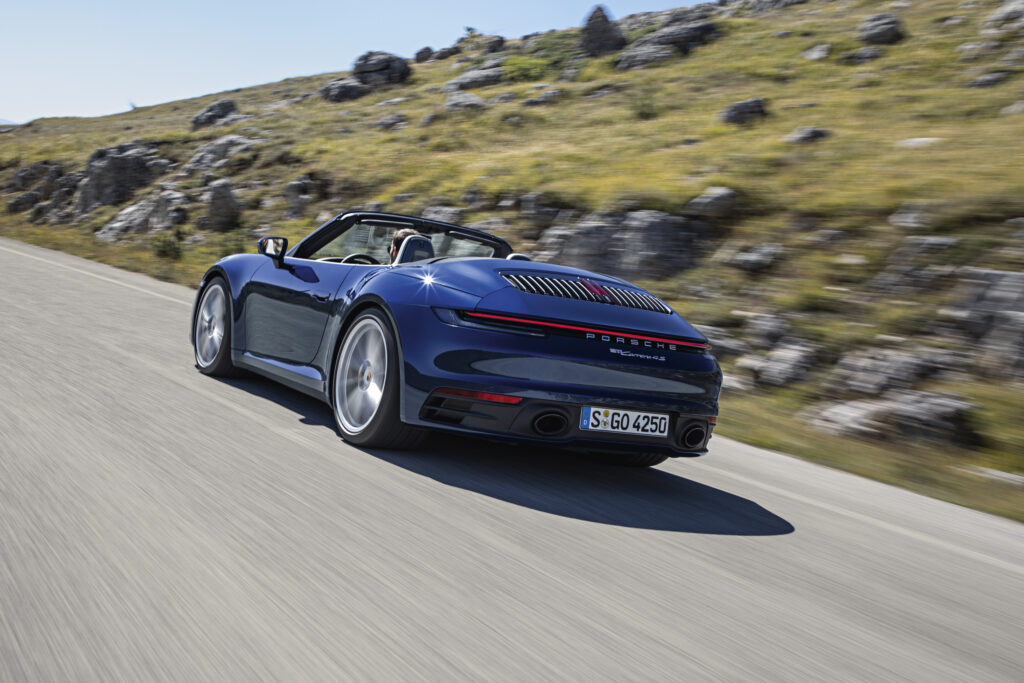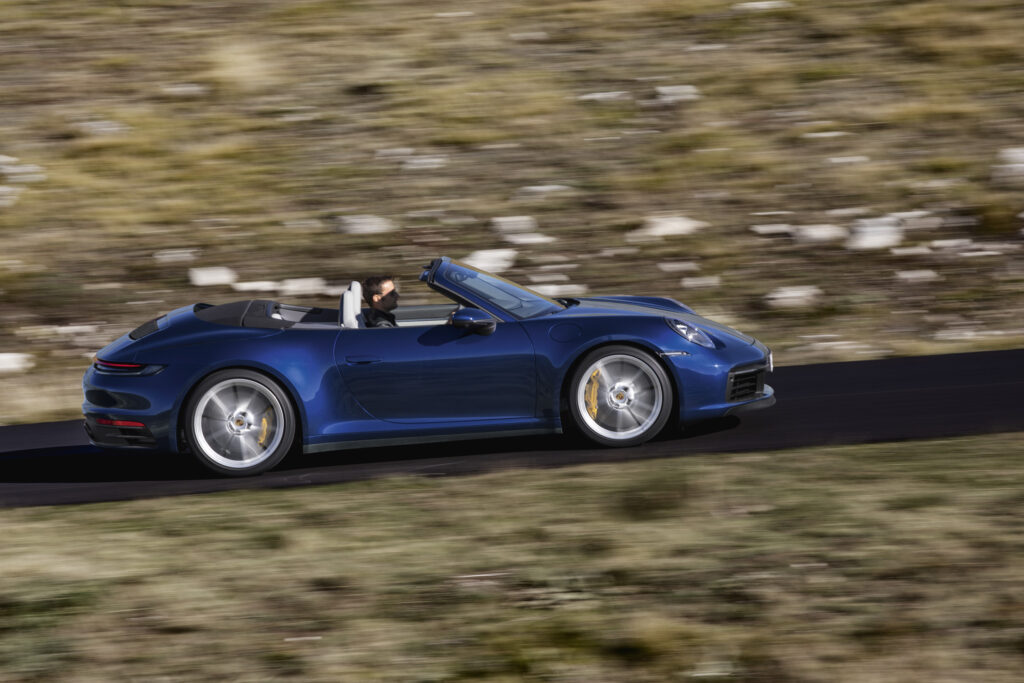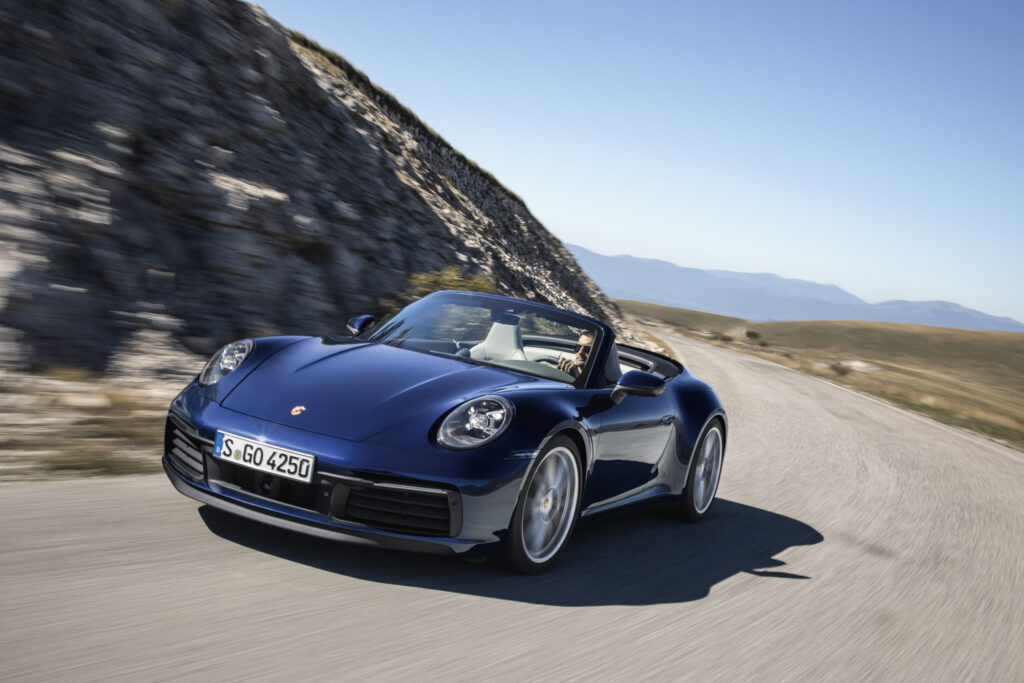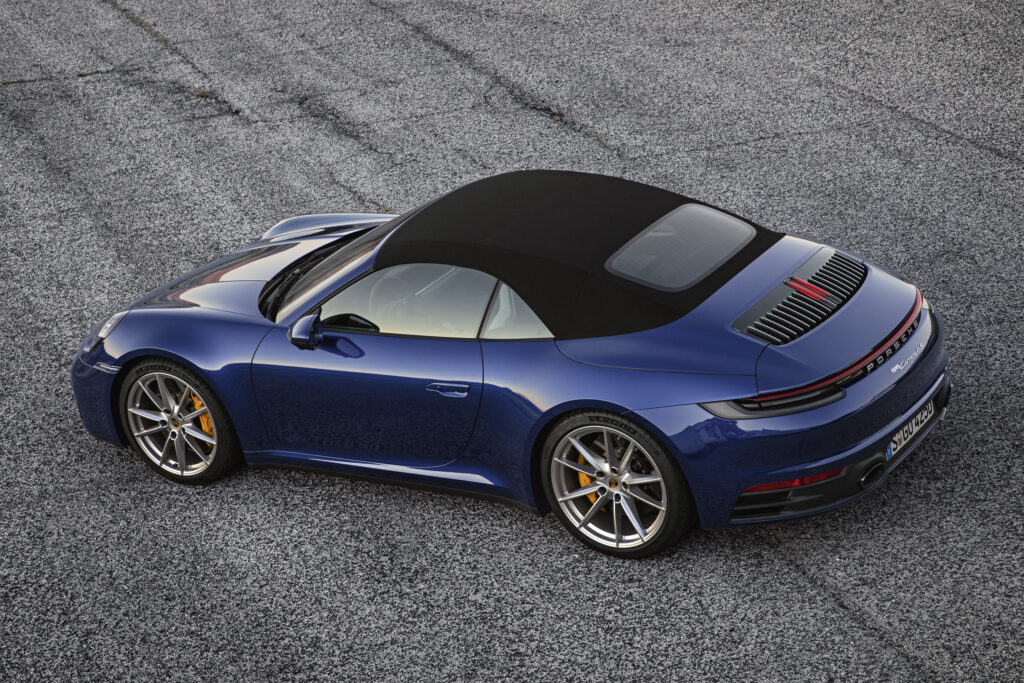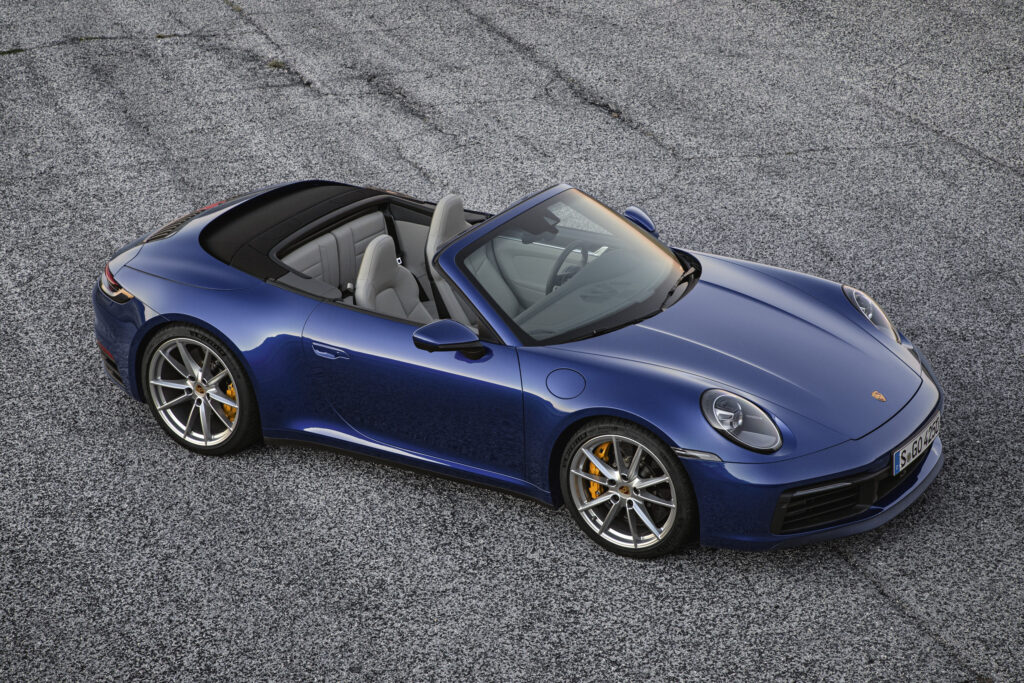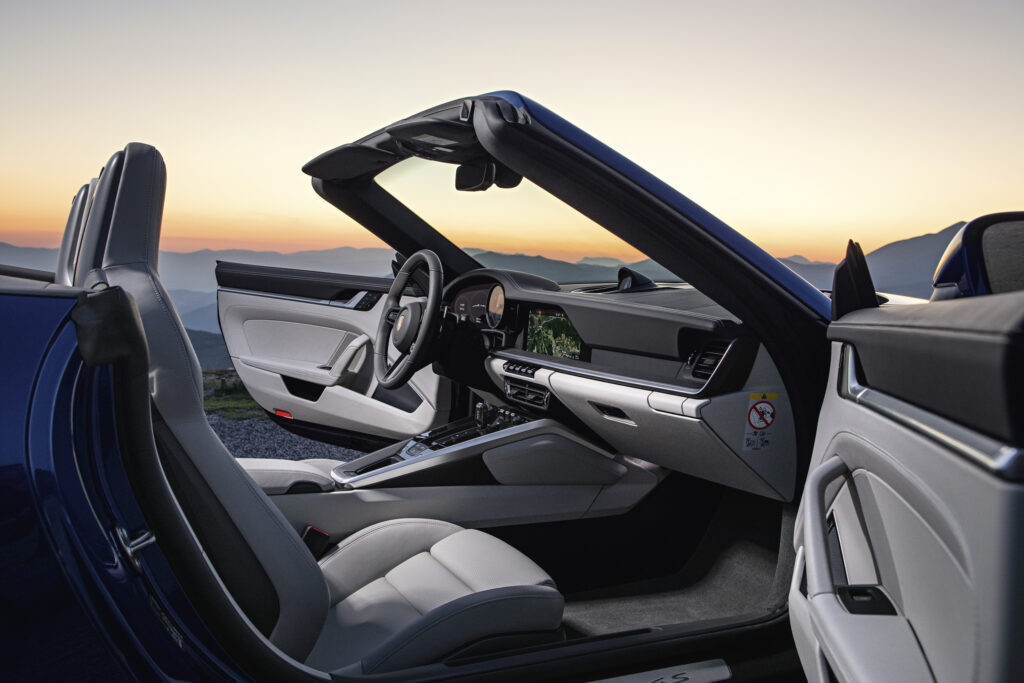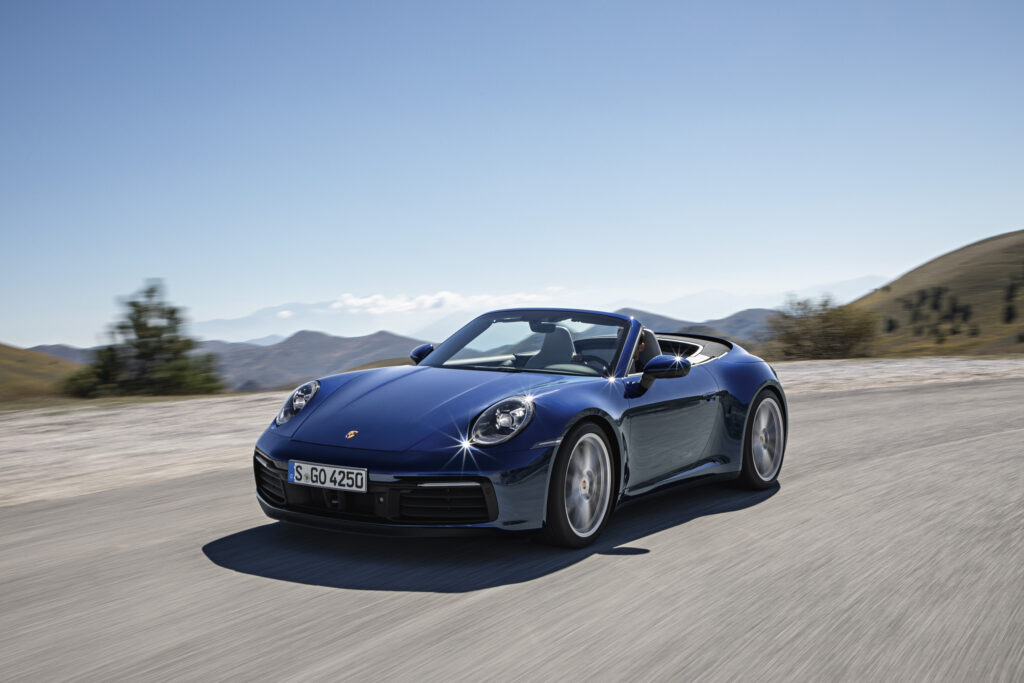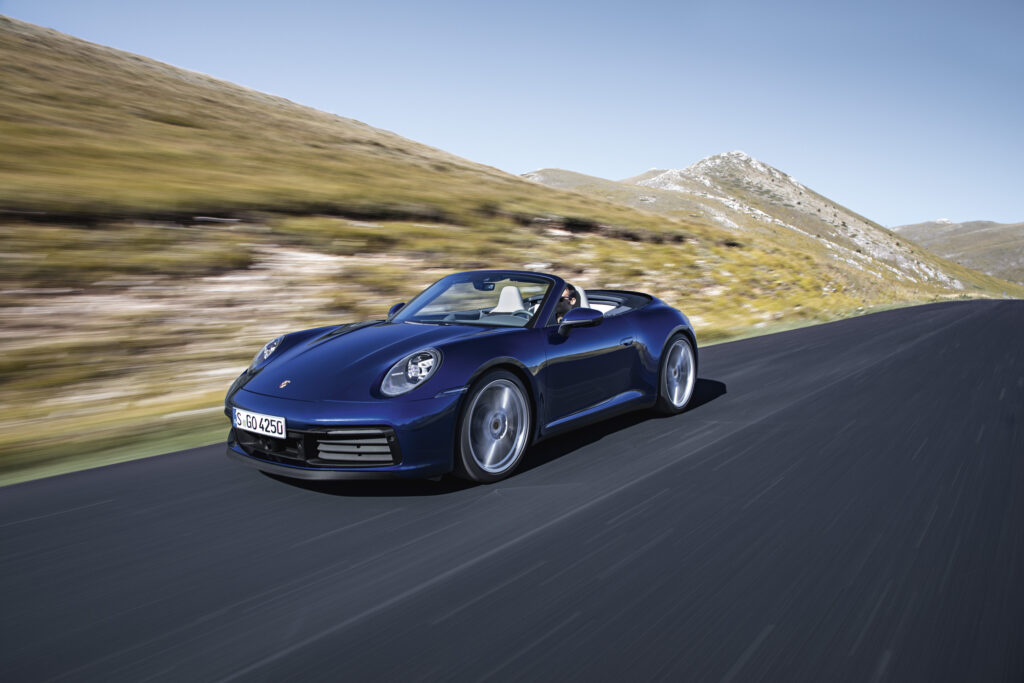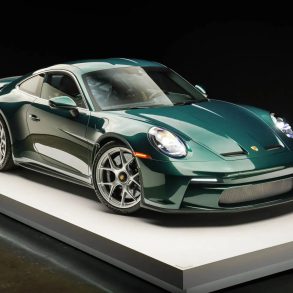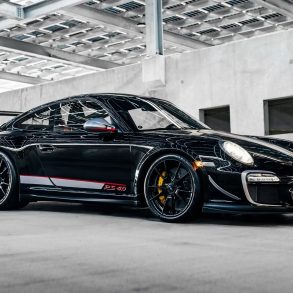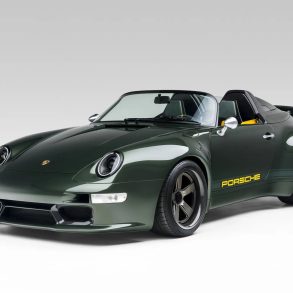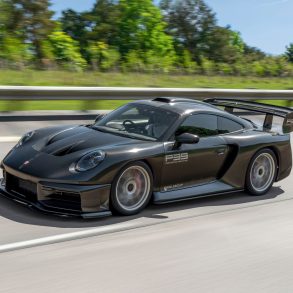Porsche 911 Carrera 4S Cabriolet (992) – Reviews, Pricing, Specs & Buyers Guide
Top down summertime driving in the current Porsche 911 Carrera 4S Cabriolet is about as good as it gets. The flat six (still) sounds great (especially with the optional sports exhaust), there is tons of torque on tap at any speed and rpm and the handling is superb. The current Carrera 4S Cabriolet 911 checks all of the right boxes, as while it has matured into almost a GT-type car; it still boasts more performance than ever.
Like the rest of Carrera S models, the Carrera 4S Cabriolet is powered by the same 3.0-liter twin-turbo flat-six that makes 443 horsepower and 390 ft lbs of torque. It also comes standard with the same eight-speed twin-clutch automatic transmission with the same gear ratios. The 4S of course has the benefit of an added clutch and differential up front and for those of us who live in places with snow/ice in the winter but still have hot summers, it may be the best Porsche 911 for all those conditions.
Speaking of wet-conditions, Porsche has developed an all-new Wet Mode, which is included as standard. The 4S detects water on the road, preconditions the stability control and anti-lock brake systems accordingly, and warns the driver. A camera-based warning and brake assist system detects the risk of collision with moving objects and initiates emergency braking if necessary.
The 4S Cabriolet’s all wheel drive system was further developed from the last generation 991.2 Carrera 4S Cabriolet. The increased performance is thanks to further development of the front axle drive. The clutch and differential unit are now water-cooled and have reinforced clutches to increase durability and load capacity. The increased actuating torques of the clutches improve the latter’s adjustment accuracy and thus the capability of the driven front axle. The enhanced front axle drive in combination with Porsche Traction Management (PTM) promote a further enhancement to the already impressive traction on snow, as well as in wet and dry conditions.
The folding top on the 4S Cabriolet is made out of insulated cloth; and thanks to a new “panel bow” design, it is able to perfectly mirror the Coupe’s smooth lines, without any of its magnesium structure visible through the fabric. It’s also lighter, features a heated flush-mounted glass rear window, and folds in just 12-seconds. The quicker one touch operation is equally smooth and near silent, and an integrated wind deflector keeps the interior quiet enough to have a soft conversation with your travel mate.
The fabric roof has a glass rear window and can be opened or closed at velocities of up to 31 mph in 12 seconds, which may sound like forever compared to the cars’ acceleration times but is actually quite speedy. An electrically operated wind deflector helps keep things calm in the cabin when the top is lowered. New standard equipment for both variants include electrically operated door handles, LED headlamps, a variable-position rear spoiler, and a seamless light bar across the rear.
That’s because the performance gap between 911 Coupe and Cabriolet is closer than ever before. Cutting a car’s roof off inherently creates some structural issues that can affect handling, and the added weight of the electronic top mechanism is an unnecessary bit of ballast. Yet the Carrera 4S Cabriolet is so quick, so sharp and so unrelentingly rewarding, the tradeoffs for going topless are pretty much nonexistent.
All sheetmetal is now aluminum on the cabriolets, and as all 992s now feature wide bodywork, the new drop-tops measure 71.2 inches wide up front and 72.9 inches wide out back. As with the coupe, the car has staggered-diameter wheels measuring 20 inches in the front and 21 inches at the rear. It’s likely the non-S cars will use a 19- and 20-inch setup.
Performance-wise, all-wheel drive doesn’t make a big difference to the straight line numbers. 0 – 60 mph in the Carrera S Cabriolet is 3.4 seconds while the Carrera 4S Cabriolet does it in the same 3.4 seconds (both with the Sport Chrono Package that gives you launch control). Over the quarter-mile, the Carrera 4S is 0.1 second slower than the Carrera S Cabriolet, with a crazy-fast time of 11.8 seconds. Top speed is more than enough at 188 mph.
Updates and Pricing for 2022
Prices for the 2022 Porsche 911 Carrera 4S start at $138,550 (including mandatory destination charges of $1,350). Porsche upgraded the infotainment system on the 2022 911 to include a new 10.9-inch touchscreen interface that the company calls both simplified and flexible in its personalization. It comes with wireless Apple CarPlay, and for the first time, the 911 gets Android Auto compatibility. Porsche also extended its connected services from one year to three years before reverting to a subscription model. Those services include natural voice commands activated by “Hey Porsche,” online map updates, and navigation with real-time traffic info. Satellite radio also gets a three-month trial.
Recent Reviews
Pictures
Press Release
The 2020 Porsche 911 Carrera S and 4S Cabriolet
443 horsepower, quicker top operation and optional PASM Sport Suspension available for the first time
More muscular, more powerful, more emotional – the 2020 Porsche 911 Carrera S and 4S Cabriolet models feature a suite of new developments and enhancements. Featuring a heated glass rear window and integrated magnesium support elements, their automatic fabric top opens and closes at speeds of up to 31 miles per hour in just 12 seconds – one second quicker than before. The design and interior combine classic styling with state-of-the-art technology. The twin- turbocharged flat-six engine of the 911 Carrera S and 911 Carrera 4S Cabriolet produces 443 hp thanks to optimizations both within and outside the engine. The engine is mated to a new eight- speed PDK dual-clutch transmission. The new PASM chassis with wider track widths features wheels with different diameters on the front and rear axles for the first time. Complementing the increase in engine performance, the PASM Sport Suspension featuring stiffer springs and sway bars as well as a 0.39 inch (10 mm) lower ride height is optionally available on the new 911 Carrera S and 4S Cabriolet models for the first time. Previously, it was only available for S and GTS Coupe models. The steering is more direct and the brakes are more responsive.
With the 911 Carrera S Cabriolet reaching 60 miles per hour from standstill in just 3.7 seconds, and the 911 Carrera 4S Cabriolet with all-wheel drive taking 3.6 seconds, each model is 0.4 seconds quicker than its predecessor. The optional Sport Chrono Package reduces this time by a further 0.2 seconds to 3.5 seconds for the 911 Carrera S Cabriolet and 3.4 seconds for the 911 Carrera 4S Cabriolet.
The exterior design is completely new and emphasizes the leap in performance for this generation of 911. The rear-wheel-drive 911 Carrera S Cabriolet now shares the body with the all-wheel drive model, which is 44 millimeters wider at the rear than the previous rear-wheel drive S model. Both models are 45 millimeters wider at the front axle than before. Between the new LED headlights, a front luggage compartment lid with a pronounced recess evokes the design of the first 911 generations. The flush integration of the door handles that extend electrically when needed accentuates the tapered and smooth side contour. The rear spoiler is significantly larger than before, while a seamless, elegant light bar spans the entire width of the vehicle. Apart from the front and rear fasciae, the entire outer skin is now made of aluminum.
The completely new interior is characterized by the clear and straight lines of the dashboard with recessed instruments. Alongside the central tachometer – typical for Porsche – two thin, frameless freeform displays supply information to the driver. The 10.9-inch touchscreen of the Porsche Communication Management (PCM) can be operated quickly and intuitively thanks to the new architecture. In terms of digitalization, the 911 takes the next step into the future with permanent connectivity as well as new functions and services. As standard, the PCM features online navigation and Porsche Connect Plus.
New assistance systems increase safety and comfort.
The new 2020 911 is the first car in the world to feature an innovative system for recognizing significant amounts of water on the road. The Wet driving mode automatically sets the cars stability control and anti-lock brake systems up for optimal operation in wet conditions when these are detected. It also gives the driver the option of tailoring the vehicle’s drivetrain further to these adverse conditions at the touch of a button. The warning and brake assist system — also fitted as standard — detects the risk of collisions with vehicles, pedestrians, and cyclists. It also initiates a warning or emergency braking if necessary. Night Vision Assist with a thermal imaging camera is optionally available for the 911 for the first time. Optional Adaptive Cruise Control comprises automatic distance control with a stop-and-go function and reversible occupant protection. The optional LED matrix headlights each have 84 LEDs and a unique four-point signature daytime running light that extends backwards in a three- dimensional form. Porsche has also extended the list of comfort options to include an Ionizer. This feature improves the quality of the air inside the vehicle, working in combination with the standard cabin air filter.
Pricing and availability
The 2020 911 Carrera S Cabriolet has a base MSRP of $126,100, while the 2020 911 Carrera 4S Cabriolet will be offered starting at $133,400, each not including the $1,250 delivery, processing and handling fee. The models can be ordered now and are expected to reach U.S. dealers in late summer 2019.
Convertible top and aerodynamics
Innovative lightweight roof with Coupe characteristics
The eye-catching feature of the 2020 911 Carrera Cabriolet is the unique panel bow convertible top. Thanks to the innovative technology, it has a coupe-like roof curvature when closed fabric roof, which also offers aerodynamic benefits. A new, lighter hydraulic roof drive allows the convertible top to be opened and closed in around 12 seconds at up to 31 miles per hour. The roof is operated by a button located in the center console. Porsche traditionally places high demands on the convertible top of the 911. Like for all other previous 911 models, this folding roof is a completely new development. With contours closely resembling those of the Coupe, the fabric roof elegantly spans the arc from the windshield frame to the convertible top compartment lid. There are no visible bows under the fabric and no sections interrupt the flowing design. Even the heated rear glass window is practically flush and well integrated into the structure with just a minimal joint.
Porsche development: panel bow convertible top made of lightweight aluminum
The innovative panel bow convertible top design makes it possible to achieve this previously unattainable form for fabric roofs. Here, the entire soft top – apart from the side sections – spans a rigid roof surface composed of four individual segments that abut each other seamlessly. The four elements are the front roof frame, two panel bows and the rear window. Like the other segments, the window frame is made of magnesium. A majority of the frame guide rods are also made of this very light material. Only the side guides, actuators and rear bow are made of aluminum. All frame parts are connected via kinematics, so that just one hydraulic cylinder is needed on each side to move the convertible top. For the locking mechanism, Porsche has opted for the proven electric central closure mechanism supported by side centering pins.
There is no fixed connection between the panel bows and the fabric of the roof, so that the four magnesium segments can fold flush over one another in the proven Z-folding mechanism when the roof is opened. This unique design means that the opened roof package consisting of the roof fabric, frame, panel bows and rear window, measuring just 9 inches (23 centimeters) in height and around 22 inches (55 centimeters) in length, has minimal space requirements. While the front section of the roof remains visible in the open position, the sickle-shaped convertible top compartment lid covers the rear portion as before. This large lid stretches down to the spoiler, which is larger than previously. When the top is closed, the vehicle occupants enjoy levels of climate control and interior noise that come very close to those of the Coupe.
The entire surface of the exterior fabric is lined with an insulating mat. In the interior, the roof segments are covered with rigid roof panels that provide an enveloping interior feel. The side sections are also covered with fabric, so that no technical components are visible when the roof is closed. The headroom is also roughly equivalent to that of the Coupe.
Electrically operated, fully integrated wind deflector
The integrated and electrically operated wind deflector ensures increased comfort in the 911 Carrera Cabriolet at higher speeds. The wind deflector is secured on a U-shaped support hoop, which is fully integrated in the rear area when folded down and does not restrict the space of the rear seats. The hoop can be raised within two seconds at the push of a button and unrolls a mesh that is tensioned at right angles between the front seat backrests by a second movable frame element. The wind deflector can be opened and closed up to a speed of 75 miles per hour. When the top is open, it guarantees very good protection against drafts and minimum wind noise. The wind deflector takes into account the position of the electrically adjustable front seats. For example, deployment is prevented if one of the backrests is in the movement range of the wind deflector. A raised wind deflector is automatically retracted when the roof is closed.
Adaptive rear spoiler now with 45 percent larger active area
The variable aerodynamic concept of the Coupe was adopted for the new 911 Carrera Cabriolet with adapted parameters. The form of the spoiler blade is adapted to the specific rear end contours of the Cabriolet. When the convertible top is closed, the spoiler positions correspond to those of the Coupe because the new roof generates a practically identical airflow pattern. This means that the spoiler extends into the Performance position at 56 mph when the roof is closed.
This changes when the roof is open, and the spoiler then moves to specially developed, steeper positions. Depending on the vehicle configuration, the spoiler is also extended to different heights and angles. In addition, a closing element is activated at the front spoiler edge by means of a special articulated kinematic mechanism which ensures optimum air flow over the spoiler blade. The spoiler is automatically extended at 56 mph and retracted at 37 mph, but can also be extended below these speeds at the push of a button. The front cooling air flaps round off the aerodynamic concept. When the roof is open, they also open automatically and completely above a speed of 75 mph. The optional Sport Chrono Package allows direct activation of the rear spoiler via the “Sport” and “Sport+” driving modes. Top track speed is always reached in the Performance position.
Cd = 0.31: Cabriolet with exemplary aerodynamics
The basic elements of the aerodynamic concept for the 911 Carrera Cabriolet are the streamlined body surface contours, the convertible top, the enlarged variable rear spoiler and the cooling system with its adaptive air flaps at the front which does not need large air intakes under the vehicle and therefore allows a practically smooth vehicle underbody. Optimized air intake and air outlet cross-sections also improve cooling air routing, so the Cd value of 0.31 for the 911 Carrera S Cabriolet is maintained – when the roof is closed – in spite of the increased engine and braking power.
Automatically deploying supplemental safety bars also increase rigidity
The 911 Carrera S and 4S Cabriolet have automatically deploying supplemental safety bars. They essentially consist of a compact, self-supporting portal frame made of welded, high-strength extruded aluminum sections. Due to its high strength, the supporting frame is also used for body reinforcement: it contributes to the torsional rigidity of the Cabriolet through diagonal struts to the B-pillars and convertible top compartment.
In the event of an imminent roll-over, two newly developed cassette modules behind the rear seats are extended by spring pressure; triggering takes place pyrotechnically by a micro gas generator. If the convertible top is closed, a carbide metal pin on each of the two cassettes breaks through the safety glass of the rear window. Accidental triggering is practically impossible because sensing and actuation and continuous monitoring are performed by the high-precision airbag control unit with integrated roll-over sensor.
This monitors every change in the body inclination, longitudinal and transverse acceleration as well as road contact.
Design and interior
Classic lines re-interpreted
The new 911 is wider and more muscular. The contours are familiar and unmistakably based on the Porsche design DNA, but are still strikingly new. The fabric top of the Cabriolet does nothing to change that. It picks up the roof contour, the so-called flyline, and extends it to the rear of the vehicle. The fabric top is available in a choice of colors: black, blue, brown and red. The rear- wheel drive 911 Carrera S Cabriolet now shares the body with the all-wheel drive model, which is 44 millimeters wider at the rear than the previous rear-wheel drive S model. Both models are
45 millimeters wider at the front axle than before. Between the new LED headlights, a front luggage compartment lid with a pronounced recess evokes the design of the first 911 generations. The flush integration of the door handles that extend electrically when needed accentuates the tapered and smooth side contour. The rear spoiler is significantly larger than before, while a seamless, elegant light bar spans the entire width of the vehicle.
Front luggage compartment lid in the style of the G series 911 models
The front end revives a traditional feature of earlier G-series 911 models: a forward-extended front luggage compartment lid with a distinctive recess in front of the windshield. Both elements lengthen the front of the vehicle and make it look more dynamic. At the same time, the new LED headlights demonstrate the technological progress of the 911. These headlights exhibit the round and upright shape typical for 911 models and are integrated into the front fenders almost seamlessly. The design of the optional LED matrix headlights is a visual highlight and accentuates the technology used in them. The optimized daytime running lights ensure that the 911 has an even more striking presence.
Wide body with smooth surfaces
With an unchanged wheelbase, the new 911 is now 0.78 inches (20 millimeters longer), but is above all much wider: 1.8 inches (45 millimeters) at the front on all models and 1.7 inches (44 millimeters) at the rear of the Carrera S. The new 911 seems flatter, particularly when viewed from the front. The modern, clear-cut lines of the front end are continued along the side of the vehicle. The door gives the impression of being seamlessly integrated between the front and rear fenders. Defined by linear contours, it is integrated without any frills. The sweep of the side contour starts lower down than on the previous model to create a visually lower center of gravity and underlines the hunkered down appearance of the new 911. Like on the recently introduced Coupe models, the wheels on the rear axle are one inch larger in diameter than previously (21 inches compared to 20 inches) and emphasize this further. Flush door handles, which pop out electrically when needed, and a rectangular, aerodynamically enhanced exterior mirror design complete the clean, powerfully modelled vehicle side. The exterior mirrors have also been redesigned and optimized to minimize wind noise, and can be optionally fitted with an electric folding function. The standard black lower mirror trim is also optionally available in the vehicle color.
Rear end with new LED light bar
With its recessed contours and pronounced fascia, the rear end is an archetypal feature of the 911. It is functionally divided into three elements on the Cabriolet: the multi-part convertible top structure is folded in Z-form under the electrically operated rear lid. The large rear spoiler has been adapted to the lid shape. The rear end is largely the same as on the Coupe. The new, one- piece LED light bar and low positioning of the license plate create a dramatic look and clearly distinguish the new generation from the previous models.
The vertically arranged louvers of the air intake echo the contours of the rear window. On the Cabriolet, the distance between the air intake and window is slightly larger than on the Coupe due to the rear lid design. The centrally located third brake light has also been integrated into the intake louvers. Since the brake light is hidden when the rear spoiler is extended, a second brake light has been incorporated into the spoiler.
As a distinguishing feature, the rear-wheel drive models have black louvers, while the all-wheel drive models have silver elements in the rear decklid grill. The rear spoiler is positioned directly below the air intake and is now significantly wider. It extends almost to the outer edge of the tail lights.
The new continuous LED light bar immediately catches the eye. This light band is not interrupted by any joints or seams, and therefore provides the new 911 with an unmistakable night design. Thanks to the integrated tail light modules, it was possible to redesign the turn signal indicators. They enclose the light bar and provide it with visual support. They also frame the three- dimensional PORSCHE logo. The model designation is located under this in a newly created font. This is a very modern homage to the style used at Porsche in the 1970s.
The rear fascia continues the idea of a coherent graphic look. This was achieved by relocating the license plate downwards between the tailpipes of the exhaust system. These are now integrated into in the rear end in a flush manner so that this is terminated downwards without any visual interruption. Integration of the reflectors and outer air outlets in the black area of the rear end also makes for a cleaner, wider and more linear appearance.
Newly developed interior
The completely new interior is a milestone in the development of the 911. The new cockpit evokes the virtues already found in the first 911 generation: clarity and formal unambiguity. For example, the traditional analog tachometer is now flanked by two frameless free-form displays that appear to float. As on the original 911, the new dashboard covers the entire width between two horizontal wing levels. In the middle, a control panel with five pushbuttons, styled to look like classic toggle switches, forms the transition to the center console with an integrated touchpad. An ignition key is no longer needed: the new 911 features an integrated key fob to start the engine as standard – positioned on the left of the steering column, of course.
Under the roof-like wing, the dashboard has a black recessed horizontal operating level. This is dominated in front of the driver by the five classic Porsche round instruments with the analog tachometer in the middle. The exposed glass edges of the seven-inch free-form displays emphasize their elegance and lightness.
The new 10.9-inch PCM touchscreen display is incorporated in a flush manner. The trim surface in front of the control unit serves as a hand rest and supports fast and distraction-free operation. Located underneath there is a new switch unit with five buttons for direct access to important vehicle functions. These can be operated intuitively thanks to their exposed position. Depending on the vehicle equipment, Wet Mode can be activated here by means of button, or the PASM dampers can adjusted to a firmer setting. The center air vent is the transition to the center console. This has a touch-sensitive high-gloss surface that corresponds to the PCM display.
New option: Ionizer
The optional ionizer in the air flow of the climate control system is also new. This reduces the number of germs and other pollutants contained in the air. The air quality in the passenger compartment is improved, thereby noticeably increasing the well-being of the vehicle occupants.
The functionality of the selector lever for the Porsche Doppelkupplung (PDK) has been reduced, and the lever is now much more compact than before. This is made possible by purely electronic control of the new eight-speed PDK. The form and surface texture have been adapted to the design of the touch switches. The clearly structured, purist door panel combines elegance with a high level of functionality and offers plenty of storage space.
The new steering wheel generation embodies typical Porsche principles such as lightness and precision in an even more distinctive and attractive manner. The multifunction control elements blend harmoniously into the steering wheel and emphasize its lightness. The visually revamped mode switch of the optional Sport Chrono Package has a more modern look and is now easier to use. The control stalks have also been redesigned for perfect functionality and ergonomics. The GT steering wheels are optionally available in different versions. All steering wheels have a diameter of 360 millimeters.
New seat generation with more comfort
The seats have also been fundamentally modified. Thanks to lightweight construction, the new design reduces their weight by around 7 pounds (three kilograms). The changed geometry provides significantly improved lateral support in the shoulder area. Although the seat is now positioned five millimeters lower and has a minimally thinner seat cushion, seating comfort has been significantly improved. The seats also evoke the simple operation of previous 911 models through ergonomically easier folding by means of classic leather loops. A new stitching pattern in combination with the completely renewed backrest shell ensures a very differentiated appearance that blends harmoniously into the interior. The rear seats in the new 911 have also been improved. They now have a backrest which is about 0.78 inches (20 millimeters) higher and a wider seat cushion.
The backrests of the optional Sport Seats Plus can also be personalized. A wide range of trim elements is available for this. For example, the rear-facing center section of the backrest can be enhanced with inserts made of leather, wood, brushed aluminum or even carbon fiber. Even painted elements are possible.
The inner sides of the doors have also been redesigned and continue the horizontal lines of the dashboard. The high-quality metal door trim elements have a seamless transition to the newly designed door openers so that they form a visual unit. This new geometry of the trim surfaces offers extensive personalization options in combination with a wide choice of Exclusive trims.
Like for the previous model, a full leather interior is also optionally available. The choice of additional decorative stitching, optionally in a contrasting color, is new. The steering wheel is also offered with a contrasting stitching. The leather interior is available in Black, Slate Grey, Graphite Blue or Bordeaux Red.
Engine and drivetrain
Enhanced power, greater efficiency
The twin-turbocharged flat-six engines also enter the next generation with the new 911 Carrera S and 4S Cabriolet, and are shared with the recently introduced Coupe models. The focus of development was primarily on enhancing performance even further. New, larger turbochargers with symmetrical layout and electrically controlled wastegate valves, a completely redesigned charge air cooling system, and piezo injectors lead to improvements in all relevant areas: responsiveness, power, torque build-up, efficiency and free revving nature. In addition to the power increase from 420 hp to 443 hp at 6,500 rpm, the engine offers 22 lb.-ft. more torque than the previous S model, developing 390 lb.-ft. over a broad powerband between 2,300 rpm and 5,000 rpm.
The new twin-turbocharged flat-six cylinder engine features forced induction using an almost completely new intake system. Two symmetrical turbochargers with larger chamber volumes replace the previous parts. As a result, the compressor and turbine wheels now rotate in opposite directions. The diameter of the turbine wheels has been increased by three millimeters to 48, while the 55-millimeter compressor wheel is now four millimeters larger than previously. Thanks to a newly developed lightweight cast manifold and the modified turbine housings, it was possible to improve the air flow conditions, turbine wheel outflow and responsiveness. This increases efficiency, torque and power.
The control of the bypass valves has also been changed. The valves are no longer adjusted by a vacuum, but electrically using stepper motors, making boost pressure control faster and more precise overall. The maximum boost pressure of the 911 Carrera S and 4S is around 16 psi (1.1 bar).
Increased efficiency: charge air coolers now located under the rear decklid grill
Further downstream in the intake section, the compressed air flows through the two newly positioned charge air coolers. They have traded positions with the air filter compared with the previous generation. Instead of being located at the sides in the rear fenders, the charge air coolers are now located directly over the engine in a central position under the rear decklid grill. This new position improves the airflow. In combination with the larger charge air coolers, this significantly enhances intercooler efficiency.
The complete engine was the focus of further development and numerous details have been optimized. For the first time, piezo-controlled injectors inject fuel directly into the combustion chambers. This allows only one injection using a maximum fuel pressure of 2,900 psi (200 bar). Piezo injectors also open and close faster than the previous solenoid-operated components. As a result, the injection quantity can be divided into up to eight partial injections per cycle. Furthermore, the injector opens outwards so that the fuel is distributed better, thanks to finer droplets in the combustion chamber.
Asymmetrical valve lift for better combustion
For the first time, the variable valve timing system VarioCam Plus controls gas exchange using asymmetrical intake camshafts. The two adjacent valves of a cylinder open with a different degree of lift under partial load. Previously, the small valve lift of both intake valves was a uniform 3.6 millimeters. Now, the lift is 2.0 millimeters and 4.5 millimeters. This and various other detailed optimizations improve fuel management and combustion – reducing consumption and emissions. This also improves the smoothness of the engine at low rpms and loads. After switching to full lift, the valves revert to opening with the same amount of lift.
Emotional sound both inside and outside
The unmistakable sound of the 911 is a significant part of the highly enjoyable and unique driving experience that makes the car so unique. With this in mind, the engineers paid great attention to the sound balance of the intake and exhaust sides in development. A sound symposer with a switchable second channel behind the rear trim panel accentuates the classic flat-six sound organically. The exhaust systems have been revamped to offer a characteristic and attractive sound experience for the Porsche 911, in spite of stricter noise regulations. The twin-branch exhaust system now includes map-controlled and fully variable exhaust flaps. This control system ensures both optimum power output as well as an emotional sound. The flaps are controlled electrically by means of stepper motors, replacing the vacuum controlled setup on the previous models. This makes it possible to set intermediate positions – for an even more emotional sound experience. A Sport Exhaust System is also available. Whereas the standard system features twin tailpipes on each side, the Sport Exhaust System has two oval tips, available in Silver or Black.
New eight-speed PDK dual-clutch transmission
Like the 2020 911 Carrera S and 911 Carrera 4S Coupe models, the new 911 Carrera S and 4S Cabriolet are being launched with an eight-speed dual-clutch transmission (PDK), which is fitted as standard. A manual transmission will be available at a later date. Compared with the optional seven-speed dual clutch transmission in the previous models, the new PDK offers a host of improvements. The driver can directly feel the enhanced combination of comfort, performance and efficiency. All gears have new ratios: first through seventh gears are now shorter, while eighth gear is longer than the previous seventh gear. This made it possible to use a longer final-drive ratio, which lowers engine speeds in the upper gears further. The result is a harmonious and well- matched gear ratio spread and further potential to reduce fuel consumption. The vehicle still reaches top track speed in sixth gear. The use of a controlled oil pump and advanced fuel-efficient engine oils are further measures that reduce both power losses and fuel consumption. The oil pressure required for gear changes and clutch operation is controlled by demand, reducing power loss.
Quick shifts for greater dynamics
The new quick shift function allows the driving dynamics of the 911 to be experienced even more intensely. This function is available for upshifts both in manual mode and in automatic mode when Sport Plus is activated. Like in the 911 GT3, 911 GT3 RS and 911 GT2 RS, gearshifts are even quicker and the response times to upshift requests are particularly short. Particularly quick shifts take place at high engine speeds and loads. They are made possible by significantly improved clutch control during the gear changes. The hydraulically controlled clutch changeover takes place much faster thanks to an additional filling bypass.
Optional Sport Chrono Package with a new mode switch
The optional Sport Chrono Package is the go-to choice when it comes to increasing driving performance and driving pleasure. This includes the new mode switch with Sport Response button, PSM Sport Mode, dynamic engine mounts as well as the dash-mounted chronograph and the Porsche Track Precision app. The new mode switch in the steering wheel selects the driving mode, displaying the active mode in the instrument cluster.
The dynamic engine mounts – which have a new position better aligned to the engine’s center of gravity – combine the advantages of a hard and soft engine mount. They increase both comfort and stability thanks to electronic control. When driving on enclosed tracks, PSM Sport mode can be activated separately and sets the stability system to a particularly dynamic setting, while retaining the safety function of stability control when needed. In this mode drivers can exploit the dynamic capabilities of their vehicle in a safe environment. Inspired by racing, the Sport Response button offers the option of setting engine and transmission responsiveness to maximum performance for 20 seconds. The Porsche Track Precision lets drivers record lap times and driving data on racetracks. This data can be saved and managed via the smartphone and also shared and compared with other drivers.
In combination with the optional Sport Chrono Package, the new Wet mode, which is standard for all 911 models, can be selected via the mode switch, replacing the Wet mode toggle switch cars without the Sport Chrono Package are equipped with.
911 Carrera 4S with enhanced all-wheel drive system
The increased performance of the new 911 Carrera 4S Cabriolet goes hand-in-hand with the further development of the front-axle drive. The clutch and differential unit is now water-cooled and has reinforced clutch discs to increase durability and load capacity. The increased actuating torques at the clutch improve the latter’s adjustment accuracy and thus the capability of the additional front-axle drive. The enhanced front-axle transmission in combination with PTM (Porsche Traction Management) promote even better traction on snow, as well as in wet and dry conditions. Furthermore, the precision, performance and load capability of the all-wheel drive system for racetrack use have been optimized.
Chassis and brakes
Racing technology: Staggered tire and wheel diameter for the first time
The chassis of the Porsche 911 sets standards for sports cars – and has done so in every generation for more than 50 years. With the chassis of the new 911, Porsche has improved the chassis performance potential even further. One element of this is the new staggered wheel and tire dimensions, with 20-inch wheels on the front axle and 21-inch wheels on the rear axle. As before, the tires on the rear axle are significantly wider than on the front wheels. This results in a track that is 1.8 inches (46 millimeter) wider at the front of both models, as well as a 1.5 inch (39 millimeter) wider track width at the rear of the rear-wheel drive 911 Carrera S. This combination enables the rear axle to build up higher lateral stability, and improves the traction of the rear- wheel-driven 911 even further. The staggered tires also have a considerable influence on the vehicle’s balance. The handling is even more neutral and controllable. The vehicle exhibits very little tendency to understeer or oversteer, even during spirited driving. The next generation of Porsche Active Suspension Management (PASM) completes the refined suspension design, offering a significantly enhanced balance of agile handling and ride comfort suitable for daily use. The PASM suspension is equipped with active shock absorbers as standard. The PASM Sport suspension is available as an option, offering a sportier tune, stiffer springs and dampers as well as a 0.39-inch (10 millimeter) lower ride height.
Sportier and more comfortable: further developed PASM with a wider spread
Porsche has developed PASM further for the new generation of 911. The latest generation of dampers features fully revised engineering. The main stage valve and the pressure chambers for the rebound and compression stage are controlled within a few milliseconds by means of a high- precision magnetic control valve that is infinitely adjustable. This enables precise adjustment of the damping force at any time. In addition, the Porsche chassis specialists have developed separate software controls for the new damper technology, which perfectly align the damper function to their application in the new 911.
The combination of new hardware and software results in significant advantages. When needed, the new PASM offers significantly softer shock damping than the previous system, resulting in greater comfort in both the compression and rebound stage. Short, quick, successive bump impacts – like those generated by cobblestones – are absorbed with much greater success. At the same time, the new PASM allows the dampers to act more firmly, resulting in significant driving dynamics advantages in regards to roll stability, steering behavior, and cornering grip.
A PASM Sport Suspension with a 0.39-inch (10-millimeter) lower ride height is also optionally available. The entire setup is designed specifically for enhanced driving dynamics and enables both greater cornering agility on curves and greater high-speed stability.
The Wet driving mode: a world first fitted as standard
The 2020 Porsche 911 is the first car in the world to feature an innovative system that recognizes significant amounts of water on the road, including the Wet driving mode that can be manually selected at any time. This program has been specially developed to support the driver in wet conditions. The system uses acoustic sensors in the front wheel wells to detect water spray splashing inside, and can detect water on the road. This makes it fundamentally different from rain sensors used for windshield wipers, which only react to water droplets on the windscreen, independently of road conditions. When a certain amount of water is recognized, the response behavior of the PSM and PTM systems is automatically preconditioned to suit wet road conditions. The system then informs the driver of the detected water and recommends manually switching to Wet mode.
The Wet mode can be activated using the toggle switch above the center console. When equipped with the optional Sport Chrono Package, it is integrated in the mode switch. If the driver activates this mode, the Porsche Stability Management (PSM), Porsche Traction Management (PTM) aerodynamics optional Porsche Torque Vectoring (PTV) Plus, and throttle response are adapted to the conditions in such a way as to guarantee the best possible driving stability. The cooling air flaps open, the throttle response is softer, and PSM Off or Sport mode can no longer be activated. The Wet mode is essentially based on a concept that the Porsche Advanced Development department had already developed to in the mid-1990s, as part of the Prometheus European research program.
New brake system setup with optimized brake response
The new staggered wheel diameters with a new generation of tires led to a completely new chassis setup. This resulted in further improvements in wet grip and dry handling as well as in rolling resistance. The spring and sway bar rates are higher and the brake system operates more precisely. Because the new rear wheels can transmit a higher amount of braking force, the diameter of the rear brake rotors on the 2020 Porsche 911 Carrera S and 4S has been increased from 13 inches (330 millimeters) to 13.8 inches (350 millimeters). The brake pedal ratio has been shortened. The pedal is now made of an organic sheet composite material consisting of steel, glass fiber and plastics. It weighs around 300 grams less than the previous steel component. This leads to a more immediate brake response, and the driver can also feel a very precise pressure point because of the firm connection. Performance oriented drivers in particular will appreciated the optimized pedal feel. The brake system modifications are rounded off by the change from a pneumatic brake booster to an electric booster.
The race track-proven Porsche Ceramic Composite Brake (PCCB) system is still optionally available for all 911 models. The ceramic brake offers a significantly reduced weight compared to cast-iron rotors and even higher thermal capacity.
Direct steering ratio for greater agility
In order to further increase the agility and dynamic turn-in behavior of the new 911, the steering ratio is around 11% more direct compared to the previous model and approximately 6% more direct on vehicles equipped with optional rear-axle steering. The 911 is even more agile as a result and provides even greater driving pleasure on winding roads. A new steering controller is also used for improved steering feedback. Thanks to an enhanced algorithm, the road conditions – dry, wet or snow – can be better taken into account to achieve the desired handling.
The comfort-oriented Power Steering Plus is optionally available. At low speeds, this steering operates with an adapted steering support, enabling particularly easy maneuvering and parking.
Rear-axle steering plus lightweight battery
The optional rear axle steering improves both day-to-day usability and performance. The system has been adapted further for the new generation of 911. Depending on driving speed, it controls the rear wheels to steer up to two degrees either in the same direction as the current steering angle on the front axle, or in the opposite direction. The result is that the 911 is even more agile when cornering, and its smaller turning circle makes it easier to maneuver in urban traffic. At higher speeds, the system increases stability, when changing lanes for example. The rear-axle steering is also linked to use of a new lithium iron phosphate battery. This technology has its origins in motorsports. The service life of the lithium iron phosphate battery is 2.5 times that of a conventional lead-acid battery, but at 28 pounds (12.7 kilograms), it weighs less than half as much. The optional Porsche Dynamic Chassis Control (PDCC) is also available in conjunction with the rear-axle steering option. This system features active sway bars and practically eliminates body roll when cornering.
Optional front axle lift system
The optional electrohydraulic front-axle lift system allows the front axle to be raised by around 1.5 inches (40 millimeters) at the touch of a button. Thanks to the increased approach angle and ground clearance, the system makes it easier to drive into garages or driveways and to clear speed bumps, for example.
Body
Body with an even higher share of aluminum
With the new 911, Porsche has developed the mixed body construction throughout the vehicle further and designed a completely new body structure. The steel share of 63 percent in the previous model has now been more than halved to 30 percent, Apart from the front and rear fasciae, the outer skin is now made fully of aluminum. The new door design, made from aluminum sheet metal, reduces the weight of the bodyshell without negatively affecting stability or quality.
In addition to high-strength steels, there is increased use of extruded aluminum profiles in the bodyshell, such as for the front and rear longitudinal members, inner and outer door sills and floor reinforcements. Their share has been increased from three to 25 percent. Porsche has also used more die-cast aluminum parts on the new 911. These components include the front spring strut mount, rear tunnel housing, rear carrier, and shock absorber mounts.
The body components grouped directly around the passenger cell, as well as the A and B pillars and side roof frame, are made from ultra-high-strength, hot-formed steels. These absorb the main loads to meet crash requirements and contribute to the intelligent lightweight construction: to achieve comparable strength using aluminum components would require additional bulk and more weight.
New engine mounts reduce vibrations
The redesigned supporting structures also permitted modification of the engine mounts with very noticeable benefits. Previously, the engine was connected to a crossbar via two mounts located relatively far back. This crossbar was in turn bolted to the longitudinal members. On the new 911, the crossbar is completely omitted and the engine mounts are integrated directly in the longitudinal members, positioned around 20 cm further forward. The front connection to the transmission mounts is unchanged. As a result of the new position and tuning of the engine mounts, engine vibrations transmitted to the vehicle chassis have been significantly reduced. This improves comfort when driving on poorly surfaced roads at slow speeds as well as at higher speeds, for example when driving over bumps. At the same time, the handling benefits from the more rigid engine connection with the chassis. Fast, uneven corners can be taken with more confidence because the engine transmits fewer vibrations to the chassis with its weight. The directional stability of the 911 is therefore improved.
Electrical systems and electronics
Intelligent LED headlights for better visibility
Porsche has developed a whole host of new safety and assistance systems for the new 911. The new optional LED matrix headlights with PDLS Plus are a particular eye-catcher. These represent the apex of Porsche lighting technology. The light is distributed so that the driver always benefits from a maximum illumination of the road.
Intelligent control of light distribution means that it has also been possible to integrate additional functions that significantly increase driving comfort and safety. The cornering light is switched on and off with smooth transitions and therefore reduces strain on the eyes. The 911 is equipped with LED headlights from the factory as standard. These include auxiliary high beams and dynamic range control. They form the basis for the optional headlights with PDLS Plus, which includes dynamic cornering lights, high beam assist as well as highway and fog light functions. The LED matrix headlights are a completely new development.
Assistance systems with additional options
The new 911 offers a combination of assistance systems as standard. These make driving in everyday traffic safer and more comfortable. The standard camera-based warning and brake assist system considerably reduces the risk of collision with vehicles, pedestrians and cyclists. In its’ first stage, the system warns the driver visually and acoustically. There is then a braking jolt in the second stage if there is a higher level of danger detected. Braking initiated by the driver is reinforced up to the full braking potential of the vehicle if necessary. If the driver does not react, automatic emergency braking activates to mitigate the consequences of a collision.
The optionally available Adaptive Cruise Control system considerably extends the functional range. The package comprises automatic distance control with a stop-and-go function and reversible occupant protection. Using the radar sensor located in the middle of the central air intake and the camera, the system monitors the distance from vehicles driving in front and automatically adapts the vehicle’s speed and distance accordingly. Vehicles that cut in from adjacent lanes are also detected. If necessary, the system will brake to a standstill when following a vehicle in front. It will also use the coasting function when possible to reduce fuel consumption. In slow-moving traffic in particular, the system offers increased driving comfort and safety.
Thanks to the stop-and-go function, the 911 is able to move independently after braking to a standstill. If the vehicle stops for more than 15 seconds, pressing the accelerator or resuming the control stalk function will allow the vehicle to move again.
Optional Lane Keep Assist with Traffic Sign Recognition
Lane changes on roads with multiple lanes are among the most common risk situations. The optional Lane Keep Assist is camera-based and detects divider line markings on the roads. The system reacts with corrective steering inputs above 40 mph if the driver changes lanes without indicating. The system ensures greater comfort and improves safety on long-distance trips in particular. In addition to corrective steering inputs, an additional acoustic warning can be activated in the PCM. The system is active in the speed range between approximately 40 and 155 mph.
Lane Keep Assist is combined with a Traffic Sign Recognition function. This makes use of the same camera as well as navigation data and road signs as well as “no overtaking” signs and infer local traffic codes (from boundary signs), when entering a city, for example. Operation of the traffic sign recognition function is situation-dependent and makes use of other vehicle systems. For example, it considers wet conditions based on information from the rain sensor and displays weather-dependent speed limits. Information is displayed in the instrument cluster. In order to offer greater safety when driving on unknown and winding country roads, the system offers a cornering notification feature, which displays direction information on the instrument cluster display in advance of tight corners.
Optional Lane Change Assist with visual warning
The enhanced, optionally available Lane Change Assist function can be used in addition to Lane Keep Assist. This system uses a radar sensor to monitor the driver’s blind spots and areas to the rear of the vehicle on both sides. If the system determines that the speed and distance of following vehicles are too close for a lane change, a visual warning is displayed in the left or right exterior mirror. The system can detect vehicles in a distance range up to 70 meters and is active in a speed range between around 10 and 155 mph
New: Optional Night Vision Assist with thermal imaging camera
Using an intelligent thermal imaging camera, the optional Night Vision Assist detects persons and animals in dark conditions and makes the driver aware of them. The system has a range of up to 300 meters. The electronic system is able to classify the respective heat source and to distinguish between an animal and parked motorcycle with a warm engine, for example. Night Vision Assist is deactivated in urban areas in order to prevent false warnings such as may be caused by dogs on a leash on the pavement, for instance.
From ParkAssist to Surround View
Assistance systems make maneuvering and parking the new 911 much easier. Like on the previous model, standard front and rear ParkAssist with reversing camera– supports the driver with visual and acoustic warnings. This function uses ultrasonic sensors located at the front and rear of the vehicle. This function is supplemented with a standard reversing camera. This guides the driver by displaying a color camera image on the PCM with dynamic guidelines and distances from potential obstacles. ParkAssist with optional Surround View additionally calculates a 360° top view from four individual cameras. The PCM display now includes significantly sharper resolution, almost twice as high as it has been in previous models.
New PCM with simplified operation
The new Porsche Communication Management (PCM) with online navigation makes it much easier to control the extended Infotainment functions. Numerous vehicle functions that were previously operated via the instrument cluster or center console can now be configured in via the 10.9-inch touchscreen display of the PCM in the new 911 (up from 7.0 inches previously). Map data for the United States is pre-installed. Perspective map views and 3D navigation maps are available in many cases.
The system is intuitive to use and can be adapted to suit personal tastes. Using predefined tiles, drivers have a quick and easy way to create their own home screen including their preferred functions, such as favorite radio stations, sat-nav destinations, telephone numbers, or the Sport Exhaust function. An information widget can be added to the right- hand side of the screen, enabling users to access other functions in the PCM. For instance, the interactive area in the middle of the screen can be used to display the sat-nav, while the right-hand side is used for the phone function.
It is possible to navigate through the menus with just a few finger taps and swipe movements. As on a smartphone or tablet, scrolling is performed by simply swiping with your fingertips. The new PCM is also capable of pinch-in and pinch-out operations or display rotation with two fingers. As an additional feature, the display can recognize handwriting: navigation destinations can simply be written on the screen. Many of the PCM functions can be conveniently used by means of the online-supported voice control function, fitted as standard.
Choice of three sound systems
In addition to the standard Sound Package Plus, sound systems from BOSE® and Burmester® are available for the new 911. With twelve speakers and a total output of 570 watts, the optional BOSE® Surround Sound-System offers an extremely balanced and true sound experience. The Burmester® High-End Surround Sound System represents the top- of-the-line audio experience, also with twelve speakers and a total output of 855 watts.
Apps and services from Connect Plus
The new 911 features an enhanced range of connectivity compared to the previous model. The many different features are part of Porsche Connect Plus, which comes as standard. Using the Porsche Communication Management (PCM) system, the driver can now access Amazon Music, Smart Home functions from the service provider Nest and Radio Plus, an intelligent combination of conventional reception and web radio. Thanks to the integrated LTE-capable SIM card, the new 911 is permanently online. This function is also included as standard equipment. Also fitted as standard: the Porsche Connect app with simplified operator guidance for the central Connect functions.
Radio Plus is a further enhanced feature. This service with integrated web radio function means that a favorite radio station has practically an unlimited range if the chosen station offers an online radio channel. If the sports car leaves the range for terrestrial reception via FM, the system automatically switches to online streaming. The 911 features the improved “seamless” changeover function for the first time, so that it is practically impossible to hear the change in broadcasting source.
Online-navigation
The online navigation function with real-time traffic information is now even simpler, faster and more comprehensive. The basis for the simple search for navigation destinations is the central “finder” – represented by a magnifying glass in the header bar of the PCM. This allows the user to search for destinations with simple terms. The finder also offers a host of additional information such as fuel prices, car parks with free spaces including prices and opening hours, or also user ratings for hotels and restaurants.
Voice input of navigation destinations is also just as simple thanks to the new Voice Pilot. The Porsche voice control function has been further developed once more. Thanks to online voice recognition, voice inputs are now much more intuitive than before. For example, it is possible to simply enter a navigation destination without address details. Navigation calculation has also been optimized. This was made possible by simultaneous processing of on-board and online inputs. Route calculation for navigation therefore takes place at the same time both online and internally in the PCM. The PCM decides independently which navigation function has calculated the best route, but always starts with the result that has been calculated first. Navigation destinations can also be conveniently created not just in the PCM but also in advance of a journey, using the Porsche Connect app on a smartphone, or outside the vehicle on the “My Porsche” online platform.
One for all: Porsche Connect app for Apple and Android smartphones
The Porsche Connect app now provides the driver with even simpler and more comprehensive access to different vehicle and Connect functions using a smartphone. The app is divided into three main areas: “Navigation”; “My Vehicle” for vehicle-specific functions; and “Me” for user- specific services and settings.
Porsche Track Precision app
The Porsche Track Precision app allows 911 drivers to record, display and analyze driving data obtained on closed courses on a smartphone. Lap times can be automatically recorded via the PCM controlled GPS signal, or manually by way of the steering wheel button in the optional Sport Chrono Package. Time measurement is even more precise with the lap trigger optionally available through Porsche Tequipment.
The user interface of the Porsche Track Precision app has been completely modernized for the new 911. Use of the app on a smartphone is now even more intuitive and user-friendly.


